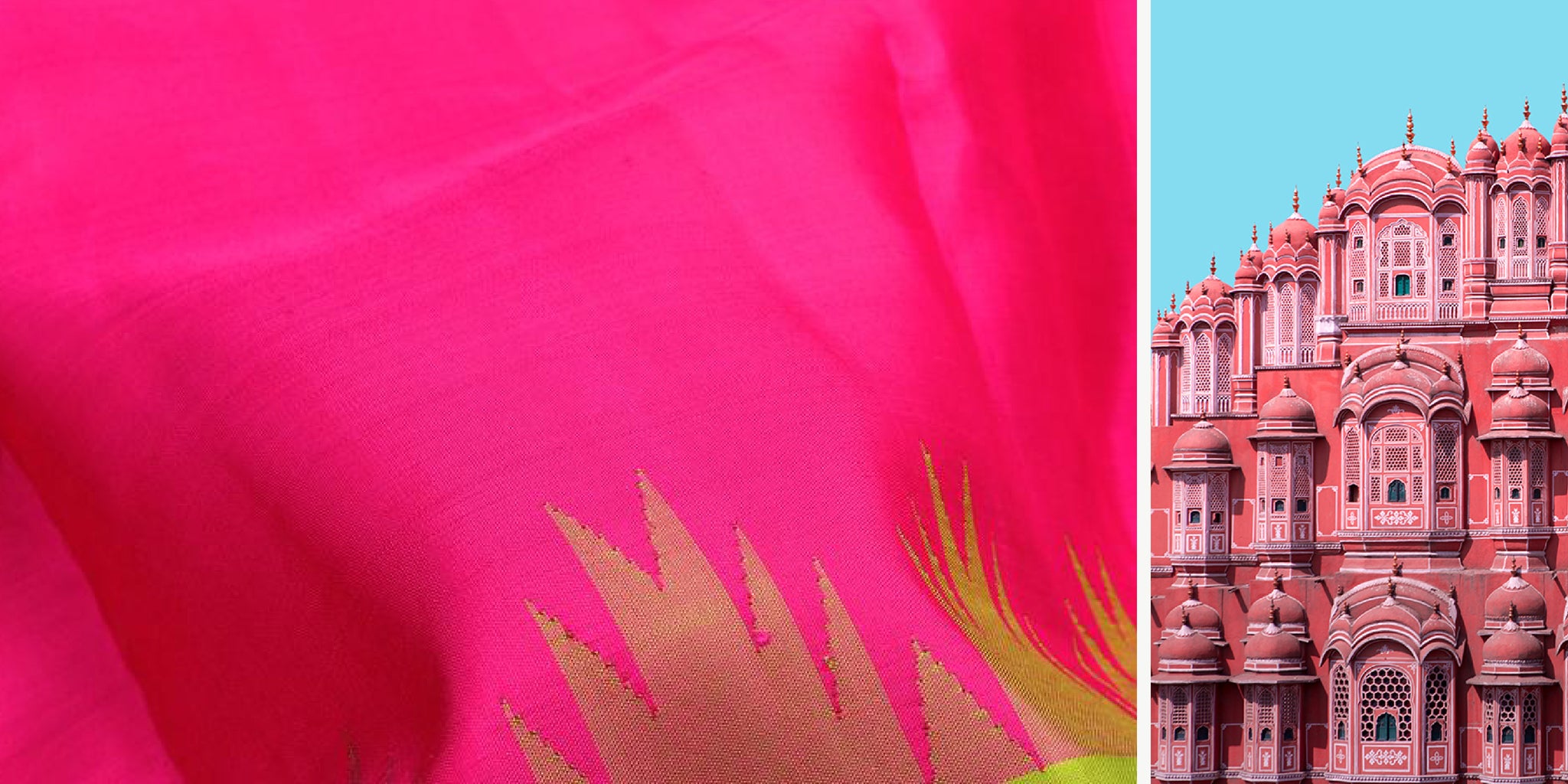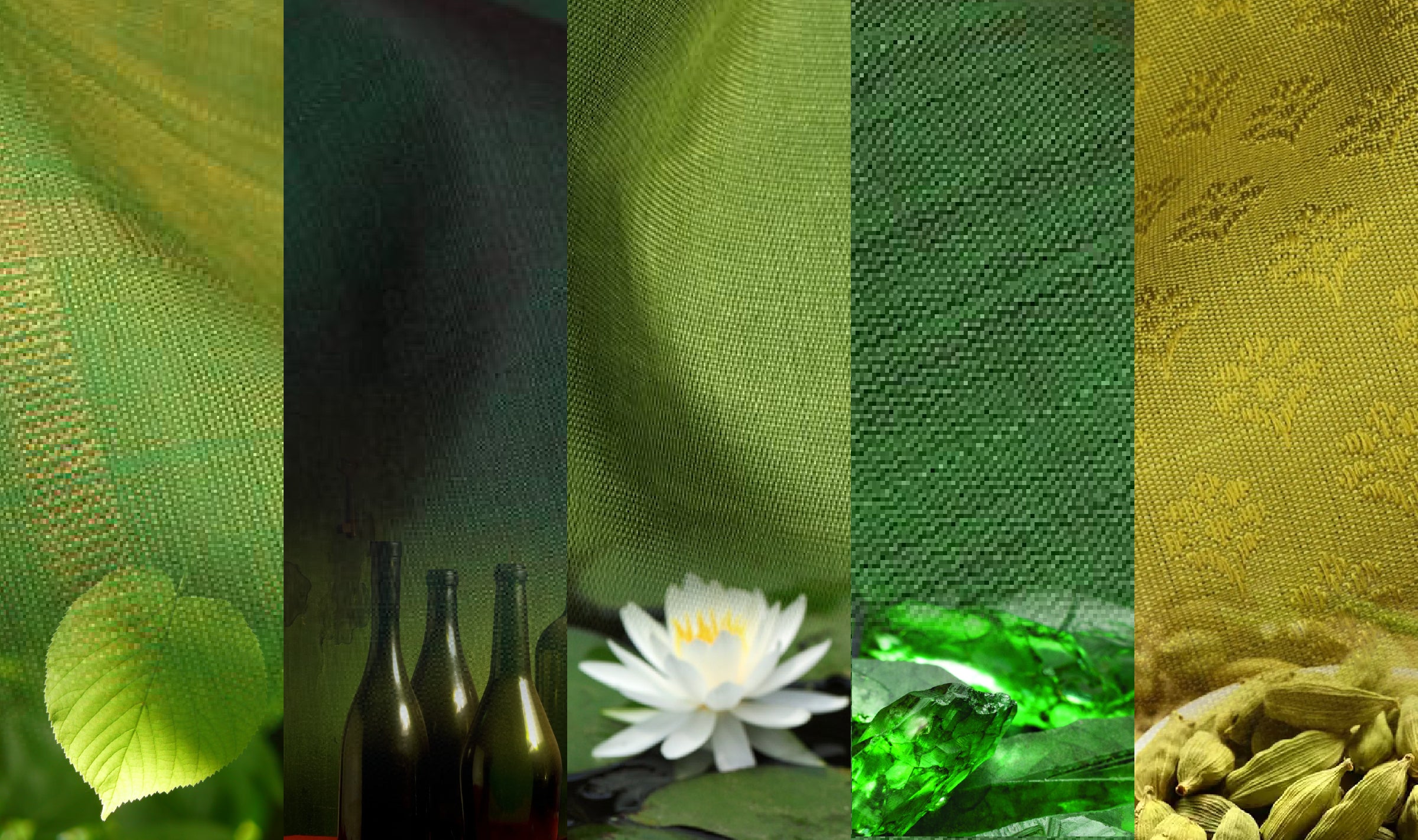Varna Sutra: Raktha - The Colour Of Passion

South India has one of the finest textile traditions, one that combines the skill of master craftsmen with elements of design, colour and weave that are drawn from the cultural and mythological history of the region. The quiet sensitivity of the weaver, rooted in custom, ritual and religious fervour, creates a special relationship between him and the cloth he weaves. Kanchipuram was an important centre of worship, and the heritage weaves were always linked with religion, mirroring existing cultural patterns.
Colours have always been closely associated with auspiciousness, symbolising varied social and religious factors, especially when choosing kanjivaram saris for weddings and special occasions. In his work Ananda Lahiri, meaning waves of happiness, the poet saint Sankara describes to devotees how the object of worship and meditation should be beautiful and auspicious -
“Mukhe may thamboolam nayana yugale kajjala kala, Lalate kashmeeram, vilasathi gale moukthilatha, Sphuarath kanchee satee Prathu kati thate hataka mayee, Bhajami sthwam gowreem nagapathee kisorimavrutham.”
- Ananda lahiri, slokam 3
In translation: “Oh Gauri, daughter of Himavan, you are so auspicious with thamboolam (betel juice) in your mouth, streaks of collyrium in your eyes, kumkumam on your forehead, a necklace of pearls adorning your neck and a golden kanchi silk saree secured with a resplendent waistband around your broad waist. I am your devotee always (constantly meditating on you).”
These strongly held beliefs in auspiciousness are firmly rooted in the fabric of life in South India. Artists breathe life into these subconscious beliefs through choice of palette and techniques of weaving. The colours of the betel leaf (‘thamboolam’), the glorious form of the rising sun in ‘kumkumam’ and the splendour of the Goddess wearing it as her ‘tilakam’ (a bindi or marking on her forehead) are all perfect illustration of red, a beloved colour that is a favourite for brides. In this edition of Varna Sutra, we focus on the colour of passion - ‘Raktha’ (red) and the entire palette, encompassing varied shades of red and pink, the universal colours of love and life.
The symbolic primary of Indian red can be found in two references – fire (‘agni’) and blood, the two natural elements that hold rich historical significance. ‘Agni’ or fire was perceived as a living being, and an early object of worship - as a source of light and heat like the sun. The mother goddess of India is depicted in red, because she is associated with the principle of creation.
Raktha or the colour red is the first colour humans mastered, fabricated, reproduced, and broke into different shades, first in painting and later in dyeing. Through the millennia it has been given primacy over all other colours. Red's pre-eminence is found in every civilisation – in the bricks and tiles of buildings, fabrics and clothing, jewels and personal accessories.
The remnants of madder-dyed fabric in Harappa indicates the antiquity of vegetable dyes, colours and mordants (substances used to enhance dyes), and India’s mastery over natural dyes. The Coromandel Coast was famous for the red derived from the roots of “manjista” (commonly known as Indian madder, and the red dye derived from this medicinal plant). The British documented the famous “Madura Red” from the plant called Chay or “Chaya Ver” in Tamil. (Chaya ver is Oldenlandia umbellata and the bright red is derived from its bark).
One of the unique things about the “real zari” in a kanjivaram sari is that a red thread runs in a single strand of zari. Not only does this lend a depth of colour to the zari, but it also adds a touch of the auspicious to the weave. In Tamil Nadu, using colour to make a statement is part of our social consciousness. We react not only to the visual impact of a colour, but to all its religious, social and historical connotations. And the local lexicon of shades is enriching, drawing from the various reds we encounter in daily life, mythology and the natural world.
‘Arakku’, a distinctive colour lying between red and maroon, marks the blossoming of pink into a deep red, and deserves a special mention for being a shade that is unique to kanjivaram and an absolute favourite choice for the bridal sari.
Below, the very many shades of the colour wheel’s most passionate palette -

Kempu (ruby red) – Kempu or the ruby red of the uncut gemstones that adorn Tanjore paintings and South Indian temple jewellery, is a colour that is striking on the kanjivaram.

Arakku – The colour of lac (which is still used a sealing agent), arakku is a favourite among most communities in Tamil Nadu for the Muhurtham sari worn by the bride on the wedding day while the mangalsutra is tied.

Milagai Pazham (chilli red) – Milagai pazham is the gorgeous glowing red of chillies, a spice that adds heat and colour to South Indian dishes. On the kanjivaram, it is a fiery, rich hue.

Kumkuma Red – This refers to the vermillion colour of the powder used for religious markings, especially on the forehead to cover the highest of the chakras – the sixth chakra of the body located in the space between our eyebrows that is considered a “third eye”. A circular red dot, or ‘tilaka’ of ‘sindura’ of a married woman is a visual social statement.

Thakkali (tomato red) – Thakkali is the colour of fresh, ripened tomatoes. On the kanjivaram this is a bright, festive colour—a distinctive shade of red shot with a tinge of orange.

Brick Red – In India, sengal or bricks are made from semman, red earth. This earthy, brown-tinted red hue is distinctive on the kanjivaram, often beautifully accented with zari.

Chemparuthy (hibiscus) - The gorgeous hibiscus flower, known as chemparuthy, is used in daily worship in South India. Its bright red hue with hints of orange finds its way onto the kanjivaram.

Pattu Roja (garden rose)– Pattu roja are the fragrant pink garden roses woven into bridal garlands in South India. The pure pink of this much-loved flower is stunning on the kanjivaram.

Paneer Roja (pink rose) – Paneer roja is the pale pink scented rose of South India used to make rose water and food flavourings. The baby pink is a delicate and elegant colour on the kanjivaram.

Vengayam (onion pink) – The pastel pink of vengayam or Indian onions is a distinctive hue, soft and pretty. Accented with rich zari, it is an unusual shade on the queen of silks.

Thamarai (lotus pink) – The sacred lotus or thamarai is revered as an ancient symbol with a divine connection to the gods and goddesses. Its pink hue is a beloved shade on the kanjivaram.

Rani pink– Rani pink is a colour unique to India, referring to a shade of shocking pink, lying between fuchsia and hot pink on the palette—a favourite colour for weddings and brides.

Kanchana – Kanchana is a beautiful shade of red shot with black or brown, a deep and lovely kanjivaram colour.
In the traditional art forms of India, the artist’s purpose is always to articulate deeper meanings and to draw parallels with the divine. In weaving, this symbolism is translated into colours, motifs and patterns, each having rich cultural or social significance.
The Goddess of Kanchipuram, Kamakshi, is the main deity of worship for most weaving communities in the town. Initially the weavers, bearers of tradition and craftsmanship, wove fabrics for the temple gods and royals; choosing palettes to adhere to specific deities and their symbols. For the Goddess they primarily wove reds, along with greens and yellows. From the historic temple facades, they drew inspiration for symbolic designs.
In the opening line of the dhyanaslokam of Lalitha Sahasranamam, the Goddess is addressed as ‘sindooraruna vigraham’ – she takes the colour of the rising sun, a resplendent vermillion. The Abhirami Andhadhi also starts in a similar way, with ‘Uthikindra sengkathir ucchi thilagam – the one who wears the rising sun as a mark on her forehead. The worship of the Devi or Goddess in South India brings to mind her myriad auspicious and beautiful forms, most often adorned with hints of red and pink.
Discover the subtle nuances in shade and significance of red or ‘Raktha’, with our latest edition of Varna Sutra. Celebrate a colour that is as loved for its striking visual appearance as it is for its deep connection to the sacred in South India.
- Sreemathy Mohan



